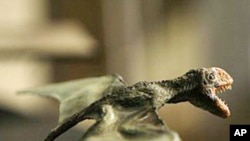Researchers say the rare fossil discovery of a female pterosaur, a prehistoric flying reptile complete with her egg, is shedding new light on the reproductive biology of a creature long popularized in books and movies but still little understood by paleontologists.
The discovery in China two years ago of the 160-million-year-old pterosaur with her egg gave scientists for the first time a way to determine the gender of pterosaurs. These ancient creatures were not technically dinosaurs, but giant flying reptiles that sported wingspans as great as 11 meters. Pterosaurs are usually depicted in films like King Kong and Jurassic Park as having enormous bony crests on the tops of their skulls. But it turns out that not all pterosaurs, also known as pterodactyls, had this feature.
The fossil of the Chinese pterosaur, nicknamed "Mrs. T," was found by a farmer in Liaoning Province in rocks that were common during the Jurassic period.
Dave Unwin, a paleontologist at University of Leicester in England, says Mrs. T. belongs to a group of pterosaurs known as Darwinopterus. Unwin says the fossil has wide pelvic bones, presumably for laying eggs, and no head crest.
Unwin says the physical features begin to answer a number of questions about pterodactyls.
"We can ask questions such as, Well, are the males on average bigger than the females or smaller than the females?” Because those kinds of things tell you an awful lot about the basic sort of way in which species work and, in some cases, how they've evolved and why they have been evolving in the way they have," he said.
Before Mrs. T, Unwin says paleontologists could not determine the genders of the 30 fossils of Darwinopterus or any pterodactyls for that matter. But he says the fossil's features of wide hips and missing crest can be used to determine the sex of all pterosaurs.
Scientists say it is extremely rare to find an egg fossilized with its parent.
Dr. Charles Deeming, a specialist in bird and reptile embryology at Great Britain's University of Lincoln says the remarkably well-preserved egg will help him determine some of the ancient creature's physical characteristics.
"What it does is it allows us to actually use details of, in my case, the egg: the dimensions of the egg, to actually predict how big the egg would have been in life, how much it would have grown to in incubation and actually how big the hatchling would have been," he said.
The University of Leicester's Unwin says the discovery of Mrs. T also launched a new study of head crests.
Since male pterodactyls had them and females did not, Unwin says it is possible male pterosaurs used their bony skull ridge to attract female mates and intimidate male suitors vying for a female's affection.
"It is only now with the discovery of this particular association that we have finally got direct evidence to be able to say right we understand crests and they are to do with gender and crests are used for signaling in some way," Unwin said.
An article describing the fossil of Darwinopterus and her egg is published this week in the journal Science.









